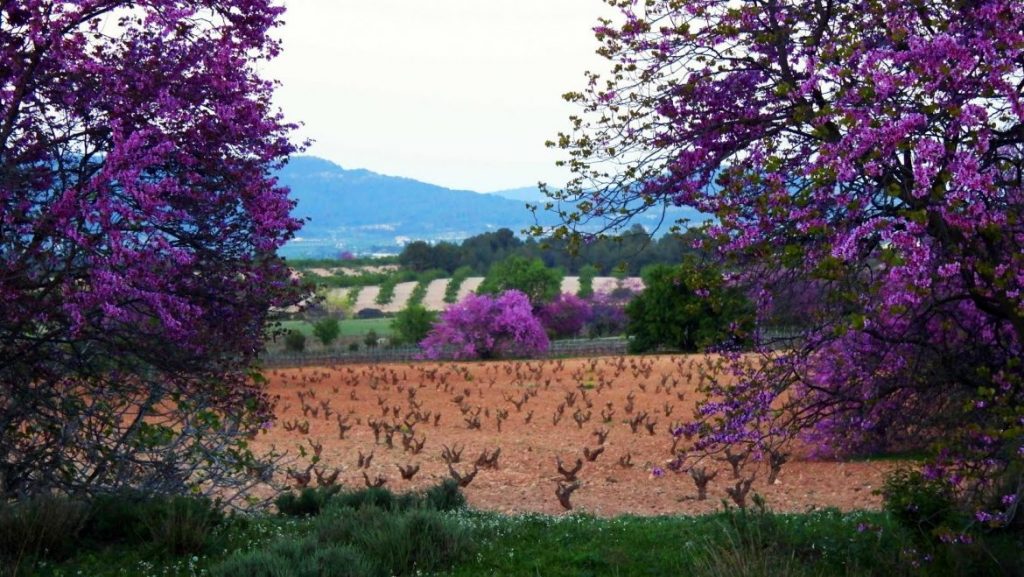Floración del Árbol del Amor
Llega el mes de abril y con él la floración del Cercis siliquastrum, conocido popularmente por ‘Árbol del Amor’. Recibe ese nombre por el color rosa y violeta de sus flores y por la hoja en forma de corazón.
También se le conoce por árbol de Judas pues según cuenta la leyenda Judas Iscariote se suicidó en uno de estos árboles. Otra de sus denominaciones es la de algarrobo loco por la asimetría con la que crecen sus ramas, aunque árbol del amor sigue siendo el más popularizado.
Lo más bonito de este árbol es sin duda su floración, que dura unos 10 días y hace que una zona en concreto de Bullas se vista con flores de colores rosas y violetas que llenan de color cualquier rincón donde se encuentre.
¿Dónde se puede contemplar?
Pues, aunque, es un árbol cada vez más común, el punto exacto para disfrutar de este obsequio que la naturaleza nos ofrece está en la parte de la Vía Verde del Noroeste que transcurre por el municipio de Bullas, a la altura de los viñedos de Carrascalejo.

A pocos metros, inmerso entre árboles, se venera el Cristo del Carrascalejo, llamado así por el paraje en el que se encuentra.
Este Cristo Crucificado se eleva sobre una peana en un recinto rodeado por una pequeña verja que invita al recogimiento y la oración en plena naturaleza. Es un lugar de gran devoción como muestra la cantidad de exvotos puestos a los pies de la imagen por los numerosos visitantes que hasta allí se acercan.
Además, muy cerquita está la Rambla o Barranco de la Regidora, un espacio natural de alto valor ecológico, que forma parte de la cuenca del río Quípar. Es un lugar de incomparable belleza ya que posee un exuberante bosque de ribera en el que destacan varias especies protegidas como la encina o el quejigo. Este paraje presenta las características típicas mediterráneas. Aquí, la fauna encuentra albergue, refugio y alimentos durante todas las estaciones del año. Entre el sotobosque de pinar y los matorrales de ribera, se pueden avistar aves como petirrojos o ruiseñores. Pero también otros vertebrados como ardillas, tejones, jabalíes; reptiles como el lagarto acelado, la culebra de collar y anfibios como el sapo corredor.
La rambla se encuentra acondicionada para la práctica del senderismo o del cicloturismo, que se puede hacer con amigos o en familia, a través de la interesante senda interpretativa que la recorre.
Es un bonito itinerario para realizar en cualquier época del año, pero es mejor en primavera si se quiere ver el árbol del amor en flor. Y si tienes la suerte de que la Rambla lleva agua podrás disfrutar de la naturaleza con todos los sentidos.

Esta ruta tan interesante, se puede hacer por partes o completa. ¿cómo? Pues partiendo del Barranco de la Regidora, en sentido circular, se llega hasta la Vía Verde del Noroeste que une Bullas con Cehegín. Y, de ahí, se alcanza el ‘Paseo del Árbol del Amor’, terminando el trayecto en el Cristo del Carrascalejo. El recorrido completo tiene una duración de aproximadamente de 3 horas, por lo que se recomienda ropa y calzado cómodo y abundante agua. Y recuerda que la naturaleza no es un basurero y lo que traigas contigo … ¡llévatelo de vuelta!







